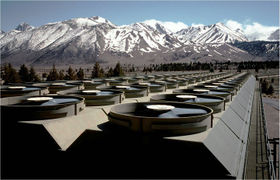Geothermal Energy
What is Geothermal Energy?

Geothermal energy is heat extracted from the Earth. Wells can be drilled into the earth to tap this energy. In the form of naturally occurring steam and hot water, geothermal energy can be drawn to the surface to generate electricity, heat and cool buildings, and serve other uses.[1][2]
Geothermal fluid temperature should be at least 300°F/149°C, although plants can operate on fluid temperatures as low as 210°F/99°C. However, in the case of Geothermal heat pumps, or GHPs, these systems use the constant temperature of the shallow Earth (40–70°F/4.5–21°C) to provide heating and cooling solutions for buildings wherever the ground can be cost-effectively accessed to depths below seasonal temperature variations.[1][3]
Geothermal is distinct from other renewables such as solar or wind because it is a considered a "baseload" technology, providing electricity 24 hours a day, 365 days a year.[4]
Geothermal on OpenEI

Provides free access to data generated from efforts funded by the Geothermal Technologies Office of the U.S. Department of Energy (DOE) and supporting projects and partnerships.

GeoBridge provides answers to some of the most pressing questions in geothermal, covering everything from home heat pump installation to careers in geothermal, educational tools, and cost savings opportunities for businesses.
Navigating the complex system of federal and state regulations and permits can be one of the biggest hurdles geothermal developers face. The Geothermal Regulatory and Permitting Information Desktop Toolkit offers a solution.

The DOE Geothermal Technologies Office (GTO) engaged in a multiyear research collaboration among national laboratories, industry, and academia to examine the potential for geothermal resources to play a key role in the nation's energy future.
The Utah FORGE (Frontier Observatory for Research in Geothermal Energy) project began in 2015 to facilitate an environment where scientists and engineers can develop, test, and accelerate breakthroughs in enhanced geothermal systems (EGS) technologies and techniques.
Access Utah FORGE (Frontier Observatory for Research in Geothermal Energy) data and visualizations.
Department of Energy Organizations

The U.S. Department of Energy’s Geothermal Technologies Office (GTO) works to reduce costs and risks associated with geothermal development by supporting innovative technologies that address key exploration and operational challenges.

NREL researches, develops, and demonstrates technologies to advance the use of geothermal energy as a clean, renewable, domestic energy source for the United States.
Geothermal Resources

In 2019, scientists evaluated the potential for geothermal energy to contribute to America’s energy future, the Geothermal Technologies Office (GTO) initiated the GeoVision: Harnessing the Heat Beneath Our Feet[5], analysis—a detailed research effort to explore opportunities for increased geothermal deployment and the pathways necessary to overcome technical and non-technical barriers to such deployment.
Visit the Geothermal Resources page to view other resource assessments that have been conducted.
See a list and map of international Geothermal Areas and Geothermal Regions.
| Study | Identified Hydrothermal | Undiscovered Hydrothermal | Near-Field EGS | Deep EGS |
|---|---|---|---|---|
| GeoVision Technology Improvement (TI) Scenario | 5,128 | 23,038 | 1,443 | 4,248,879 |
| Enhanced Geothermal Shot | 5,128 | 23,038 | 28,166 | 7,469,002 |
Geothermal Technologies

- Hydrothermal Systems
- Hydrothermal Systems use coincident heat, water, and permeable rock at shallow depths (typically <5 km) to produce electricity.
- Enhanced Geothermal Systems (EGS)
- Enhanced Geothermal Systems (EGS) are human-engineered hydrothermal reservoirs developed for commercial use.
- Co-Produced Geothermal Systems
- Low-temperature water can be used to provide heat for a number of applications, such as pools, spas, greenhouses, fish farms, and mining operations.
- Geothermal Heat Pump Systems
- Geothermal Heat Pumps are used for space heating and cooling in buildings, using the earth as a heat source in the winter and a heat sink in the summer.